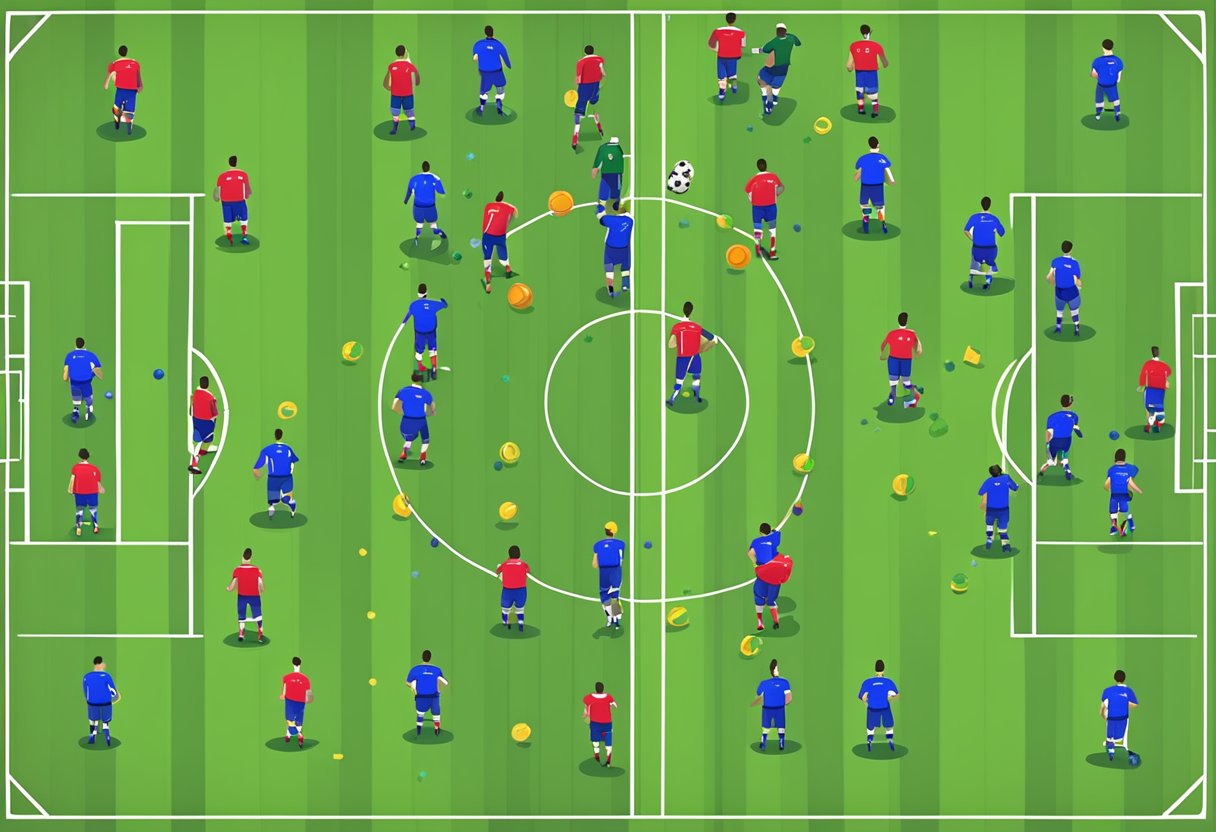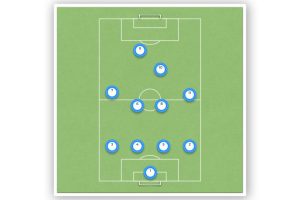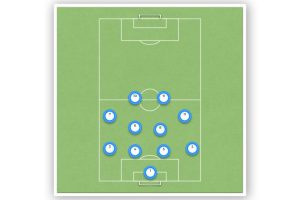Coach Defending in a 3-4-3 Soccer Formation: Strategies and Tips
Coach defending in a 3-4-3 soccer formation is a crucial aspect of the game that can make or break a team’s success. The 3-4-3 formation is an attacking formation that offers a lot of flexibility and creativity in the attacking third of the field. However, it also requires a solid defensive structure to prevent the opposition from exploiting the space left behind by the attacking players.

Defending in a 3-4-3 formation requires a combination of defensive strategies, team defending, and individual defending skills. The defenders need to work together as a unit to maintain a compact shape and prevent the opposition from penetrating through the middle. The midfielders also play a crucial role in defending by pressing the opposition and limiting their time on the ball. Individual defending skills such as tackling, marking, and intercepting are also essential in this formation as the defenders are often left in one-on-one situations.
Key Takeaways
- Defending in a 3-4-3 formation requires a combination of defensive strategies, team defending, and individual defending skills.
- The defenders need to maintain a compact shape and prevent the opposition from penetrating through the middle.
- The midfielders play a crucial role in defending by pressing the opposition and limiting their time on the ball.
Defensive Strategies in 3-4-3
In a 3-4-3 soccer formation, the defensive structure is crucial to maintain a balance between attack and defense. The coach must ensure that the team is organized and compact to prevent the opposition from exploiting gaps in the defense. Here are some defensive strategies that can be implemented in a 3-4-3 formation:
1. High Pressing and Counter-Pressing
A high pressing strategy can be employed to win the ball back in the opposition’s half. The forwards and midfielders can press the opposition when they have the ball, forcing them to make mistakes and win the ball back in dangerous areas. This can lead to quick counter-attacks and goal-scoring opportunities.
2. Zonal Marking
In a 3-4-3 formation, zonal marking can be an effective strategy to defend against the opposition’s attacks. The defenders can mark a specific zone of the pitch, rather than individual players. This helps to maintain the team’s shape and prevent the opposition from exploiting gaps in the defense.
3. Wing-backs
The wing-backs in a 3-4-3 formation have a crucial role to play in both attack and defense. They must be able to track back and defend when the opposition attacks, and also provide width in attack. The coach can instruct the wing-backs to stay back when the team is defending and push forward when the team is attacking.
4. Sweeper Keeper
The goalkeeper in a 3-4-3 formation can act as a sweeper keeper, helping to prevent counter-attacks by coming out of the box to clear the ball. This can also help to start quick counter-attacks by distributing the ball to the midfielders or forwards.
By implementing these defensive strategies, a team can effectively defend in a 3-4-3 formation. The coach must ensure that the team is well-drilled in these strategies and can execute them effectively during a match.
Defending as a Team
Defending as a team is crucial in any soccer formation, and the 3-4-3 is no exception. Each player must understand their role in the team’s defensive structure to prevent the opposition from scoring. Here are the different roles of each player in the 3-4-3 formation:
Central Defenders
The two central defenders in the 3-4-3 formation play a crucial role in defending the goal. They are responsible for marking the opposition’s forwards and preventing them from scoring. They must be strong in the air and have good positioning skills to intercept crosses and long balls. The central defenders must also communicate effectively with the goalkeeper and the rest of the team to maintain a solid defensive line.
Wing-Backs
The wing-backs in the 3-4-3 formation are responsible for defending the flanks and supporting the team’s attacks. They must be quick, agile, and have good stamina to cover the entire length of the pitch. The wing-backs must also be good at crossing the ball and creating chances for the forwards.
Midfielders
The four midfielders in the 3-4-3 formation have both defensive and attacking responsibilities. They must press the opposition’s midfielders and prevent them from creating chances. They must also support the team’s attacks by providing passes to the forwards and making runs into the box. The central midfielders must be strong in the tackle and have good vision to create chances for the team.
Forwards
The three forwards in the 3-4-3 formation must press the opposition’s defenders and prevent them from building attacks. They must be quick, agile, and have good finishing skills to score goals. The forwards must also be good at holding the ball and creating chances for their teammates.
In conclusion, defending as a team is crucial in the 3-4-3 formation. Each player must understand their role in the team’s defensive structure to prevent the opposition from scoring. The central defenders, wing-backs, midfielders, and forwards all have different responsibilities, but they must work together to maintain a solid defensive line.
Individual Defending Skills
In a 3-4-3 soccer formation, individual defending skills are crucial for the success of the team. Each player in the team must be able to defend individually, especially the defenders and midfielders. Here are some essential individual defending skills that players in a 3-4-3 formation must possess:
1. Positioning
One of the most important individual defending skills is positioning. Players must be able to position themselves correctly to prevent the opposition from getting past them. In a 3-4-3 formation, the three central defenders must be positioned in a line to prevent the opposition from breaking through the middle. The wingbacks must also be positioned correctly to prevent the opposition from attacking down the flanks.
2. Tackling
Tackling is another crucial individual defending skill. Players must be able to tackle effectively to win the ball back from the opposition. In a 3-4-3 formation, the central defenders and midfielders must be able to tackle effectively to prevent the opposition from creating chances.
3. Marking
Marking is also an essential individual defending skill. Players must be able to mark their opponents closely to prevent them from receiving the ball. In a 3-4-3 formation, the central defenders must mark the opposition strikers closely to prevent them from scoring. The midfielders must also mark their opponents closely to prevent them from creating chances.
4. Anticipation
Anticipation is another important individual defending skill. Players must be able to anticipate the movements of their opponents to intercept the ball. In a 3-4-3 formation, the central defenders and midfielders must be able to anticipate the movements of the opposition to intercept the ball and prevent them from creating chances.
5. Communication
Finally, communication is an essential individual defending skill. Players must be able to communicate effectively with each other to coordinate their defending. In a 3-4-3 formation, the defenders and midfielders must communicate effectively to prevent the opposition from creating chances.
By possessing these individual defending skills, players in a 3-4-3 formation can effectively defend against the opposition and prevent them from scoring.
Transitioning from Attack to Defense
In a 3-4-3 soccer formation, transitioning from attack to defense is crucial to prevent the opposing team from scoring. The defenders need to be alert and ready to defend as soon as the ball is lost. Here are some tips to help players transition from attack to defense effectively:
1. Communication: Communication is key when transitioning from attack to defense. The defenders should communicate with each other to ensure that they are in the right position to defend. The midfielders should also communicate with the defenders to ensure that they are aware of any potential threats.
2. Quick Reaction: Defenders need to have a quick reaction time when transitioning from attack to defense. They should be ready to sprint back to their positions as soon as the ball is lost.
3. Defensive Shape: Maintaining a good defensive shape is essential when transitioning from attack to defense. The defenders should be in the correct position to prevent the opposing team from scoring.
4. Pressing: Pressing the opposing team’s players can be an effective way to prevent them from scoring. The midfielders should press the opposing team’s midfielders to prevent them from passing the ball to their forwards.
5. Counter-Pressing: Counter-pressing is another effective way to prevent the opposing team from scoring. When the ball is lost, the midfielders should immediately press the opposing team’s players to regain possession of the ball.
By following these tips, players can effectively transition from attack to defense in a 3-4-3 soccer formation. This will help prevent the opposing team from scoring and increase the chances of winning the game.
Dealing with Opposition Attacks
When playing in a 3-4-3 soccer formation, it is crucial to have a solid defensive strategy in place to deal with opposition attacks. This section will outline two key ways to defend against wide and central attacks.
Defending Against Wide Attacks
One of the main strengths of the 3-4-3 formation is the ability to create attacking width. However, this can also leave the team vulnerable to counter-attacks down the flanks. To defend against wide attacks, the coach should instruct the wide midfielders to drop deep and help the full-backs defend against opposition wingers. This will provide additional cover and make it harder for the opposition to create chances from crosses.
Additionally, the central midfielders should shift across to cover the space left by the wide midfielders, forming a compact defensive block. The forwards should also be instructed to track back and help defend, especially if the opposition is playing with overlapping full-backs.
Defending Against Central Attacks
The 3-4-3 formation can also leave the team vulnerable to central attacks, especially if the opposition is playing with a diamond midfield. To defend against central attacks, the coach should instruct the central midfielders to drop deep and form a compact defensive block in front of the back three. This will make it harder for the opposition to play through the middle and force them to play wide.
The forwards should also be instructed to press the opposition defenders and midfielders aggressively to disrupt their passing rhythm. The back three should stay tight and compact, with the central defender taking charge and directing the defensive line.
In summary, defending in a 3-4-3 soccer formation requires a combination of tactical awareness, discipline, and teamwork. By following these defensive strategies, coaches can help their teams defend effectively against opposition attacks and maintain a solid defensive structure.
Training Drills for 3-4-3 Defense
Training drills for 3-4-3 defense formation are designed to improve the team’s defensive skills, communication, and positioning. Here are some effective drills that coaches can use to train their players:
1. 2-on-2 Support Drill
The 2-on-2 support drill is an excellent way to train defenders to work together to prevent goals. The drill involves two defenders passing the ball out to two attackers and attempting to prevent them from scoring on goal. One defender runs directly to the attacker receiving the pass while the second defender supports and is ready to pressure the second attacker if the ball is passed. This drill helps defenders to communicate and stay compact while defending against attacking players.
2. Four Corners Drill
The Four Corners drill is a great way to train defenders to stay organized and communicate effectively. In this drill, four cones are placed in a square shape, and four defenders are positioned around the cones. The coach then calls out a number, and the defenders must switch positions to the corresponding cone. This drill helps players to communicate and quickly adjust their positions based on the movement of the ball.
3. 3v3 with a Keeper Drill
The 3v3 with a Keeper drill is an excellent way to train defenders to work together to protect their goal. In this drill, three defenders face off against three attackers, with a goalkeeper in the net. The defenders must work together to prevent the attackers from scoring while the goalkeeper provides support. This drill helps defenders to communicate and stay compact while defending against attacking players.
4. Pressing Drill
The Pressing drill is a great way to train defenders to press their opponents and win the ball back quickly. In this drill, two defenders are positioned in the center of the field, with two attackers on either side. The coach then passes the ball to one of the attackers, and the defenders must quickly press the attackers and try to win the ball back. This drill helps defenders to communicate and work together to win the ball back quickly.
Overall, these training drills are effective in improving the team’s defensive skills and preparing them for the 3-4-3 defense formation. Coaches should use a combination of these drills to ensure that their players are well-prepared for the upcoming games.
Common Mistakes and Solutions
Defending in a 3-4-3 soccer formation can be challenging, especially for inexperienced coaches and players. Here are some common mistakes and solutions to help you improve your team’s defense:
Mistake: Poor Communication
Solution: Communication is key to a successful defense in any formation, and the 3-4-3 is no exception. Coaches must emphasize the importance of clear and concise communication among defenders. Players should be encouraged to call out the position of attackers, their own position, and any potential threats. To improve communication, coaches can incorporate drills that require players to communicate with each other, such as passing exercises and small-sided games.
Mistake: Leaving Gaps in Defense
Solution: The 3-4-3 formation can leave gaps in defense if not executed properly. Coaches should ensure that defenders are positioned correctly and are aware of their responsibilities. The central defenders should stay central and cover each other, while the wingbacks provide support on the flanks. The midfielders should also drop back to help defend when necessary. Coaches can use drills that emphasize defensive positioning and movement to help players understand their roles and responsibilities.
Mistake: Lack of Aggression
Solution: Defenders in a 3-4-3 formation must be aggressive and proactive in their approach. Coaches should encourage defenders to be assertive and make quick decisions. Defenders should be willing to step up and challenge attackers, rather than waiting for them to make a move. Coaches can use drills that require defenders to be aggressive, such as one-on-one defending and pressing exercises.
By avoiding these common mistakes and implementing these solutions, coaches can improve their team’s defense in a 3-4-3 formation. With practice and dedication, players can become more confident and effective defenders, leading to better results on the field.
Conclusion

In conclusion, defending in a 3-4-3 soccer formation can be challenging, but with the right strategies and techniques, it can be highly effective. Coaches need to focus on maintaining a balance between attack and defense, and ensure that their players are well-versed in their roles and responsibilities.
One important aspect of defending in a 3-4-3 formation is to have a solid defensive structure. This means that the three central defenders need to work together to cover the backline, while the wingbacks provide support on the flanks. The midfielders also need to be disciplined and aware of their defensive duties, and should be able to drop back and provide cover when necessary.
Another key strategy for defending in a 3-4-3 formation is to press high up the pitch. This can help to disrupt the opposition’s build-up play and force them into making mistakes. However, it is important to do this in a coordinated manner, with the defenders pushing up to close down space while the midfielders provide cover.
Overall, defending in a 3-4-3 formation requires a combination of tactical awareness, discipline, and teamwork. Coaches who can instill these qualities in their players are likely to see success on the pitch.
Frequently Asked Questions
What are the positions in a 3-4-3 formation?
The 3-4-3 formation consists of three defenders, four midfielders, and three forwards. The three defenders typically include a center-back and two full-backs. The four midfielders include two central midfielders and two wing-backs. The three forwards usually consist of a center forward and two wingers.
What are the weaknesses of the 3-4-3 formation?
The 3-4-3 formation’s main weakness lies in its defensive structure. With only three defenders, the formation can be vulnerable to counter-attacks, especially if the wing-backs push too far forward. Additionally, the midfield can become overcrowded, leading to a lack of creativity in attack.
What is the best formation to use against a 3-4-3?
The best formation to use against a 3-4-3 is a 4-3-3 formation. This formation offers a solid defensive structure with four defenders, three central midfielders, and three forwards. The extra defender can help neutralize the three forwards of the 3-4-3 formation, while the midfield can control the game’s tempo.
What are some drills to improve defending in a 3-4-3 formation?
One of the essential drills for defending in a 3-4-3 formation is the “small-sided game.” This drill involves playing a game with a small number of players on a smaller field, which helps players improve their defensive skills, especially in one-on-one situations. Another useful drill is the “shadow defending” drill, where defenders practice positioning themselves between the ball and the goal.
How do you defend against a 3-4-3 formation?
To defend against a 3-4-3 formation, defenders must remain compact and avoid getting pulled out of position. The full-backs must be cautious about pushing too far forward, while the central defenders must work together to cover the space left by the wing-backs. Additionally, the midfielders must be disciplined and avoid getting caught out of position.
How many defenders are in a 4-3-3 formation?
A 4-3-3 formation consists of four defenders, usually two center-backs and two full-backs. The midfield consists of three central midfielders, with one playing as a defensive midfielder and two playing as attacking midfielders. The forward line consists of three players, typically one center forward and two wingers.







